Far less well known that the "usual suspects" of the cold war Budeswehr such as the Leopard, Marder and numerous tank hunters, or the Gepard SPAAG and Roland SPAAML, there was one vehicle that was the de facto inheritor of WW2 Panzerwerfer. Abbreviated as RakArtBtl-122 (it came in 110 rocket caliber only, the number referred to the combat system) this 6x6 truck based on the Magirus 178 was also known under the acronym LARS as a rocket type artillery system to pummel advancing Soviet tanks formations in the fulda gap or wherever necessary. It was replaced in the 1980s by the LARS-2.

A MTS-1 Honest John and M35 truck platform nominally of the Bundeswehr parading at Nurburgring for the NATO Jubilee.
The development of Modern Army Rocket Artillery in the Bundeswehr with a tactical ground-to-ground rocket systems, played a key role to fulfil tasks within NATO. It was complementary to a nuclear battle scenario (Many US rockets were based in Germany, like the M35 truck-mounted MGR-1 "honest john"). In the early years of the Bundeswehr, military rockets were exclusively of American origin, and in addition to the MRS-1, the Sergeant and Lance actively deployed. Still, the US Army lacked any multiple-launch rocket system as what the Soviet Army fielded based on trucks. Instead, the US focused on heavy rocket artillery systems tipped with nuclear warheads.
Meanwhile in the late 1950s and early 60s, the Bundeswehr focused on tank hunters of various types, such as the Kanonenjagdpanzer 90 and Raketenjagdpanzer. Without pezcuzs requirement, the Bundeswzhr lacked a multiple launch rocket system but it evolved at the same time were developed the Leopard and Schutzenpanzer IFVs. Complementary to US-origin artillery system such as the M107/110 and later M109, the Military staff thought of a powerful artillery system able to engage area targets, leading to the LARS 1 after it was proposed to NATO staff, and approved as it filled a niche. The 1967 tender was answered by Wegmann (weapon system), Nobel (rockets), the Swiss company Oerlikon, and Bofors from Sweden also took part but were not chosen in the end. Only Wegmann and Oerlikon were shortlisted but Wegmann offered a 36 tubes solution whereas Oerlikon solution was a single-tube with automatic reloading light enough to be carried by helicopters. Both systems were tested extensively but Wegmann was ultimately awarded the contract.
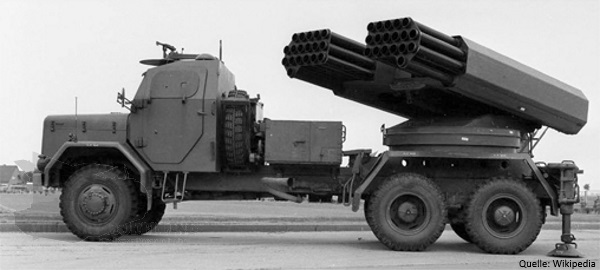
The completed system
Once the base principle the accepted contractors became thus the latter for the base platform truck (once a tracked platform was ruled out for practicity and cost), another for the weapons system. The Light Artillery Rocket System (LARS) was given to Wegmann & Co. as prime manufacturer (later consolidated into KMW, the Leopard's maker). It included a twin multiple-launcher tube canister with easy interchangeability to swap various close rocket calibers. Tests were performed on a ground facility showing shown the main launcher could be traversed a full 360° and elevated enough for optimal range. It needed to be placed on the flatbed of a suitable truck, which happened to be the tactical Magirus Truck, to be specific, the three-axle Magirus-Deutz 178 D 15 A chassis. This model succeeded to the Magirus-Deutz Jupiter in 1964 but shared most elements. The cabin was armoured, so it is treated here on tank-afv.com.
As for the rockets, they were manufactured at Nobel, and had a diameter of 110 mm (4.6 in) for a length of 2.26 meters. The company built a special test launcher with 15 tubes, trialled extensively at the Meppen firing range. Later was defined the best canister shape, with the idea of reducing flight interference for better accuracy. The launch setup is precisely tailored in sequence to avoid these issues.
For Brakes it had Dual circuit air-over-hydraulic and large Tyres of 11.00 - 20, same as the previous Jupiter. Fuel capacity was 160 liter (35 gallons) total, it is not known if the diesel was multifuel. It could however procure a flat range of 350 km (219 miles). Fording depth without preparation was 0.85 m (12 inches) but it seems not deep water fording kit was provided. In standard troop carrier version, the generous flatbed could accmodate 21 men. There was a self-unditching winch forward.
The biggest difference with the standard truck is the way it was completely transformed by Wegman. The cabin was partially armoured: This consisted in two elements: The main large shutter in front of the front windshield, hinged downwards, left flat on the engine hood when not in use, and clipsed on the roof when up. It was slanted and angled so to spouse the split windshield shape. It seems there is not even a pair of vision slits on this armoured shutter, so it does not allowed driving. Since these is no bulletproof glass either on either side of the cab, two side armoured shutters, also folded down, could be secured up when approaching the combat area. The original windows are also smaller than the original truck, thus requiring smaller shutter, which had small vision ports.
Another peculiarity was the replacement of the original truck's open storage basket over the roof, replaced by an armoured structure. Over the co-driver's/commander's position is installed a large circular hatch sliding over the driver's roof's section. It is topped by a ring mount standard to received the Rheinmetall MG-3 machine gun both for close and AA defence. There are also sources pointing our to a Browning 0.5 cal. heavy MG as well. No details are given for the armour, which also protects the crew from the rocket's blast. It is assumed proof against small arms fire and shrapnels. There are no smoke dischargers provided.
-The utility section composed of a spare tyre and tooling boxes immediately after the cabin's back, then a the main rocket storage/utility bin and just over the rear axle pairs (four main tyres) was located the main cicular base with its internal electric engine for traverse and elevation.
-The top of the mount supports a three-parts launcher: The artillery officer sat in between the two launcher on either wings. He has a small control dashboard and optics. These large prismatic sectioned canisters could accomodate either 110 or 120 mm caliber rockets. Each carries 18 drawn tubes in the 110 mm caliber variant. This each rocket launcher system truck is able to fire 36 spin-stabilized rockets within 18 seconds. Due to the lack of space, reload is perform by a specialized vehicle following the unit. When in place, the launcher is unlocked and traversed while the back deflector is lowered down as well as the two rear feet to dig into the ground.
During operations, four LARS rocket launchers constituted a launcher platoon. By launching their combined seventy-two rockets over a 1500 m () wide area, 500 m () deep could up to 14 km, the vehicles are able to hit hard an fast any formation, before withdrawing rapidly to avoid counter-battery fire. Depending on the mission, other targets can be dealt with using various rocket warheads. The fragmentation ones are best used against massed infantry adancing in the open.
The engagement target range being 9 to 14 kilometers with a relatively narrow hit pattern around 6,000 to 9,000 meters. Thius the vehicles were close enough to the front line to work directly in front of advancing combat troops, hence the armour. All fire strikes were thus strickly coordinated with combat troops. It was assumed that an enemy tank formation hit by this system with rockets tipped by the AT1 stick mines was able to reduce any formation to at least 30%. The goal was less to destroy tanks than to stop them with enough damage. Fragmentation ammunitions, the ARTRAK 110 mm, used the rocket fuse DM 54.
Before deployment, the firing positions were scouted for, chosen, then prepared. Using the on-board FERA trajectory calculator, and short range radio to communicate with other platoon's vehicles, the concentrated rocket fire was more accurate and effective. The standard in regular operation was rockets carrying a Fragmentation warhead with proximity fuses, ignited 20 meters above the ground to achieve maximum splintering effect. Something that can be crippling over towns and forests. The RakWerfer 110 SF was modernized with FERA but the concept matured and in time, a replacement was chosen for the LARS-2 system:
The last launchers were decommissioned from the 2nd/Rocket Artillery Battalion 150 on April 19, 2000. Last live shots were fired at the Munster military training area. Remaining stocks of 110 mm rockets fired with the MARS systems are now in storage but two LARS 2, are still used as test vehicles at the Military Technical Office 91 in Meppen. By In September 2021, the Federal Ministry of Defense pointed out the risk caused by leaking nitroglycerin while in storage. Around 32,000 rockets in warehouses in Meppen, Wulfen, Nörvenich, Köppern, Eft-Hellendorf and Wermutshausen were noted and were closed but no method of disposal has been precised as for 2023. This storage scandal was reported by Der Spiegel in 2022 when publishing part of the report.Sources
Development

A MTS-1 Honest John and M35 truck platform nominally of the Bundeswehr parading at Nurburgring for the NATO Jubilee.
The development of Modern Army Rocket Artillery in the Bundeswehr with a tactical ground-to-ground rocket systems, played a key role to fulfil tasks within NATO. It was complementary to a nuclear battle scenario (Many US rockets were based in Germany, like the M35 truck-mounted MGR-1 "honest john"). In the early years of the Bundeswehr, military rockets were exclusively of American origin, and in addition to the MRS-1, the Sergeant and Lance actively deployed. Still, the US Army lacked any multiple-launch rocket system as what the Soviet Army fielded based on trucks. Instead, the US focused on heavy rocket artillery systems tipped with nuclear warheads.
Meanwhile in the late 1950s and early 60s, the Bundeswehr focused on tank hunters of various types, such as the Kanonenjagdpanzer 90 and Raketenjagdpanzer. Without pezcuzs requirement, the Bundeswzhr lacked a multiple launch rocket system but it evolved at the same time were developed the Leopard and Schutzenpanzer IFVs. Complementary to US-origin artillery system such as the M107/110 and later M109, the Military staff thought of a powerful artillery system able to engage area targets, leading to the LARS 1 after it was proposed to NATO staff, and approved as it filled a niche. The 1967 tender was answered by Wegmann (weapon system), Nobel (rockets), the Swiss company Oerlikon, and Bofors from Sweden also took part but were not chosen in the end. Only Wegmann and Oerlikon were shortlisted but Wegmann offered a 36 tubes solution whereas Oerlikon solution was a single-tube with automatic reloading light enough to be carried by helicopters. Both systems were tested extensively but Wegmann was ultimately awarded the contract.

The completed system
Once the base principle the accepted contractors became thus the latter for the base platform truck (once a tracked platform was ruled out for practicity and cost), another for the weapons system. The Light Artillery Rocket System (LARS) was given to Wegmann & Co. as prime manufacturer (later consolidated into KMW, the Leopard's maker). It included a twin multiple-launcher tube canister with easy interchangeability to swap various close rocket calibers. Tests were performed on a ground facility showing shown the main launcher could be traversed a full 360° and elevated enough for optimal range. It needed to be placed on the flatbed of a suitable truck, which happened to be the tactical Magirus Truck, to be specific, the three-axle Magirus-Deutz 178 D 15 A chassis. This model succeeded to the Magirus-Deutz Jupiter in 1964 but shared most elements. The cabin was armoured, so it is treated here on tank-afv.com.
As for the rockets, they were manufactured at Nobel, and had a diameter of 110 mm (4.6 in) for a length of 2.26 meters. The company built a special test launcher with 15 tubes, trialled extensively at the Meppen firing range. Later was defined the best canister shape, with the idea of reducing flight interference for better accuracy. The launch setup is precisely tailored in sequence to avoid these issues.
Design of the Vehicle
Magirus 178 6x6
The Magirus-Deutz 178D 15A/AL started to be introduced in 1964, shortly after the Jupiter. It was almost identical but in detail. It was produced until 1967 at the Magirus factory at Ulm. This truck was 9.09 m (354 inches) long for 2.50 m (97 inches) in width and an height of 3.25 m (126 inches) and weighting overall 15.000 kg (33.000 lb.). It was powered by a Magirus air cooled V8-cylinder Diesel type F/A8L714D, with a capabity of 12.667 cm3 (773 cubic inches) rated for 178 at 2.300 rpm. It was coupled with a 6-speed, type ZF AK 6-55 tranmission with a 2 speed transfer case. The Electrical system was rated for 24 volt, negative ground. There was a Servo assisted steering and there was a Webasto heater in the cab and starter pre-heater.For Brakes it had Dual circuit air-over-hydraulic and large Tyres of 11.00 - 20, same as the previous Jupiter. Fuel capacity was 160 liter (35 gallons) total, it is not known if the diesel was multifuel. It could however procure a flat range of 350 km (219 miles). Fording depth without preparation was 0.85 m (12 inches) but it seems not deep water fording kit was provided. In standard troop carrier version, the generous flatbed could accmodate 21 men. There was a self-unditching winch forward.
The biggest difference with the standard truck is the way it was completely transformed by Wegman. The cabin was partially armoured: This consisted in two elements: The main large shutter in front of the front windshield, hinged downwards, left flat on the engine hood when not in use, and clipsed on the roof when up. It was slanted and angled so to spouse the split windshield shape. It seems there is not even a pair of vision slits on this armoured shutter, so it does not allowed driving. Since these is no bulletproof glass either on either side of the cab, two side armoured shutters, also folded down, could be secured up when approaching the combat area. The original windows are also smaller than the original truck, thus requiring smaller shutter, which had small vision ports.
Another peculiarity was the replacement of the original truck's open storage basket over the roof, replaced by an armoured structure. Over the co-driver's/commander's position is installed a large circular hatch sliding over the driver's roof's section. It is topped by a ring mount standard to received the Rheinmetall MG-3 machine gun both for close and AA defence. There are also sources pointing our to a Browning 0.5 cal. heavy MG as well. No details are given for the armour, which also protects the crew from the rocket's blast. It is assumed proof against small arms fire and shrapnels. There are no smoke dischargers provided.
The LARS I weapon system
The flatbed is composed of two sections:-The utility section composed of a spare tyre and tooling boxes immediately after the cabin's back, then a the main rocket storage/utility bin and just over the rear axle pairs (four main tyres) was located the main cicular base with its internal electric engine for traverse and elevation.
-The top of the mount supports a three-parts launcher: The artillery officer sat in between the two launcher on either wings. He has a small control dashboard and optics. These large prismatic sectioned canisters could accomodate either 110 or 120 mm caliber rockets. Each carries 18 drawn tubes in the 110 mm caliber variant. This each rocket launcher system truck is able to fire 36 spin-stabilized rockets within 18 seconds. Due to the lack of space, reload is perform by a specialized vehicle following the unit. When in place, the launcher is unlocked and traversed while the back deflector is lowered down as well as the two rear feet to dig into the ground.
Tactical Deployment
Deployment
The RakArtBtl was thus an armoured rocket launching truck with two RakWBttr 110 SF platoon attached to each division for surprise strike against large area targets. The RakW had a scatter pattern measuring 300 × 300 meters. Each firing unit comprising a single platoon of 4 vehicle were capable of firing 72 rockets in one go, but with quick reload by ready vehicles, 144 rockets in 18 seconds. The fragmentation effect was calculated to be of 864,000 steel balls, 1,152 AT1 stick mines or 720 AT2 shaped charge mines depending on the mission.During operations, four LARS rocket launchers constituted a launcher platoon. By launching their combined seventy-two rockets over a 1500 m () wide area, 500 m () deep could up to 14 km, the vehicles are able to hit hard an fast any formation, before withdrawing rapidly to avoid counter-battery fire. Depending on the mission, other targets can be dealt with using various rocket warheads. The fragmentation ones are best used against massed infantry adancing in the open.
The engagement target range being 9 to 14 kilometers with a relatively narrow hit pattern around 6,000 to 9,000 meters. Thius the vehicles were close enough to the front line to work directly in front of advancing combat troops, hence the armour. All fire strikes were thus strickly coordinated with combat troops. It was assumed that an enemy tank formation hit by this system with rockets tipped by the AT1 stick mines was able to reduce any formation to at least 30%. The goal was less to destroy tanks than to stop them with enough damage. Fragmentation ammunitions, the ARTRAK 110 mm, used the rocket fuse DM 54.
Before deployment, the firing positions were scouted for, chosen, then prepared. Using the on-board FERA trajectory calculator, and short range radio to communicate with other platoon's vehicles, the concentrated rocket fire was more accurate and effective. The standard in regular operation was rockets carrying a Fragmentation warhead with proximity fuses, ignited 20 meters above the ground to achieve maximum splintering effect. Something that can be crippling over towns and forests. The RakWerfer 110 SF was modernized with FERA but the concept matured and in time, a replacement was chosen for the LARS-2 system:
LARS-2 and MARS
In 1980, an improved version was converted, based on the MAN 7t truck. In order to improve accuracy and range towards the target, a “fire control radar artillery” (FERA) was introduced, installed on each launcher. This was also ported on current LARS-I systems. Ultimately the LARS-2 were complemented with the MARS (Medium Artillery Rocket System) rocket launcher (M270 MRLS) and both systems stayed in service until the mid-1990s (First batteries, MARS, second batteries LARS).The last launchers were decommissioned from the 2nd/Rocket Artillery Battalion 150 on April 19, 2000. Last live shots were fired at the Munster military training area. Remaining stocks of 110 mm rockets fired with the MARS systems are now in storage but two LARS 2, are still used as test vehicles at the Military Technical Office 91 in Meppen. By In September 2021, the Federal Ministry of Defense pointed out the risk caused by leaking nitroglycerin while in storage. Around 32,000 rockets in warehouses in Meppen, Wulfen, Nörvenich, Köppern, Eft-Hellendorf and Wermutshausen were noted and were closed but no method of disposal has been precised as for 2023. This storage scandal was reported by Der Spiegel in 2022 when publishing part of the report.
Sources
feuerleit-einschies-radar-artillerie-fera
artilleriekunde.de
spiegel.de
deutsche-digitale-bibliothek.de
LARS rocket storage report
LARS-2/MARS
Video
artilleriekunde.de
spiegel.de
deutsche-digitale-bibliothek.de
LARS rocket storage report
LARS-2/MARS
Video
Gallery
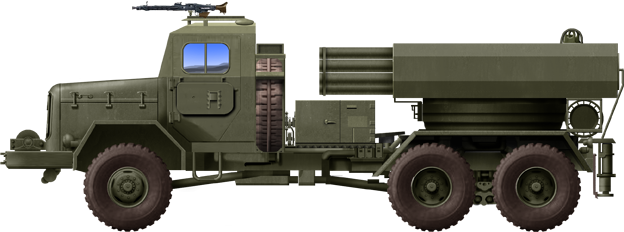
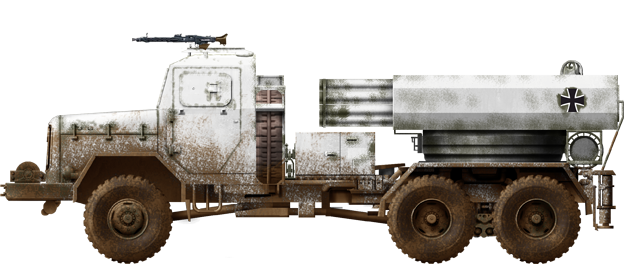

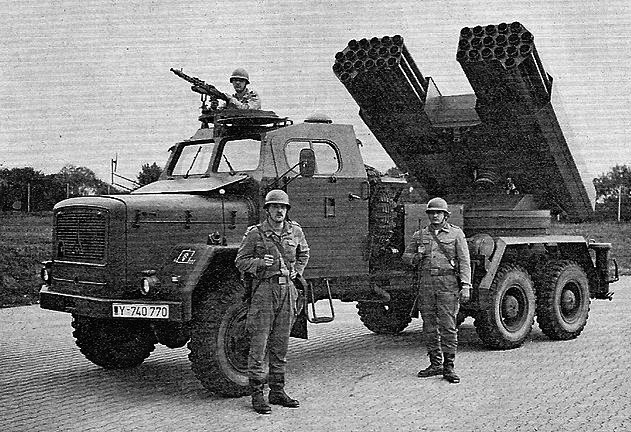

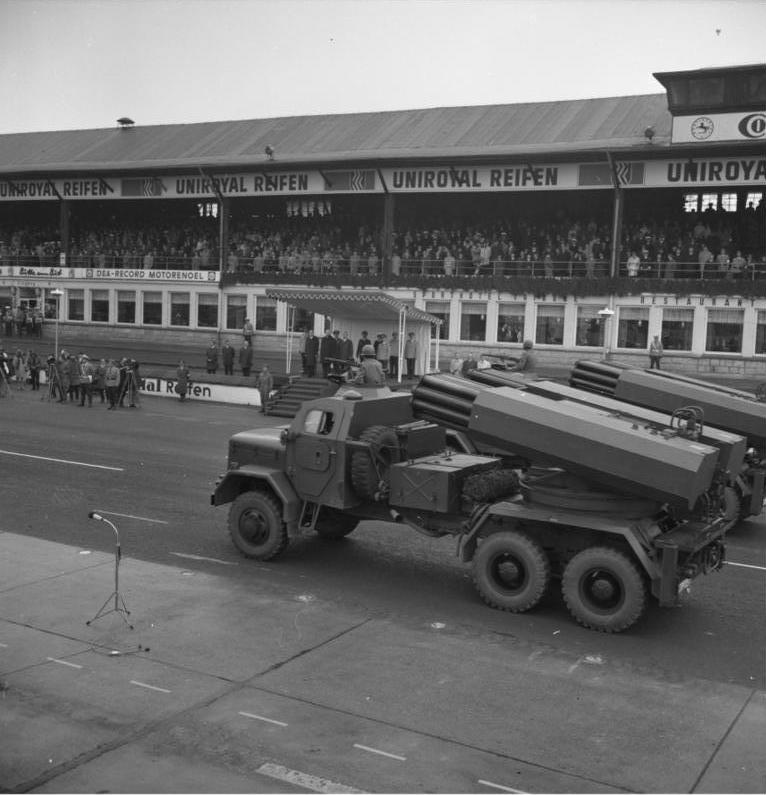
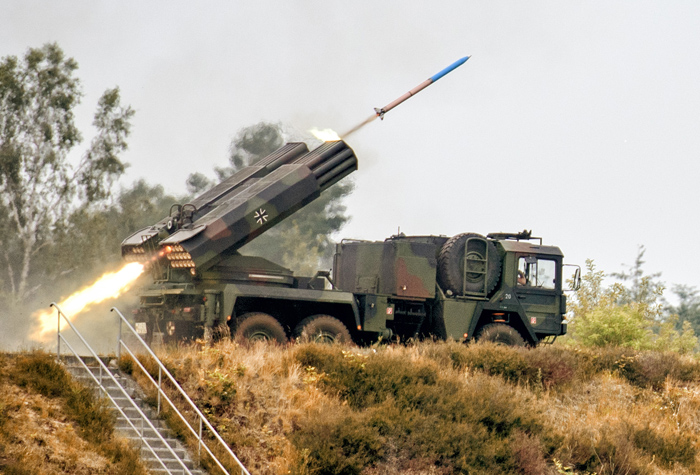

Cold War Tanks


































Cold war tanks posters

Cold War Main Battle Tanks

Cold War Soviet Army
Museums, Movies, Books & Games
The Tanks and Armor in pop culture
Tanks and armored vehicles in general are only really grasped when seen first person: The mass, the scale, it's all there. Explore also the way tanks were covered in the movie industry, in books and in video games.Movies:
Best tanks movie on warhistoryonline.com
On imdb.com
On bestsimilar.com/
miltours.com
liveabout.com/
watchmojo.com
Video Games:
pcgamesn.com
historyhit.com
levvvel.com
vg247.com/best-tank-games
mmobomb.com/
alienwarearena.com

